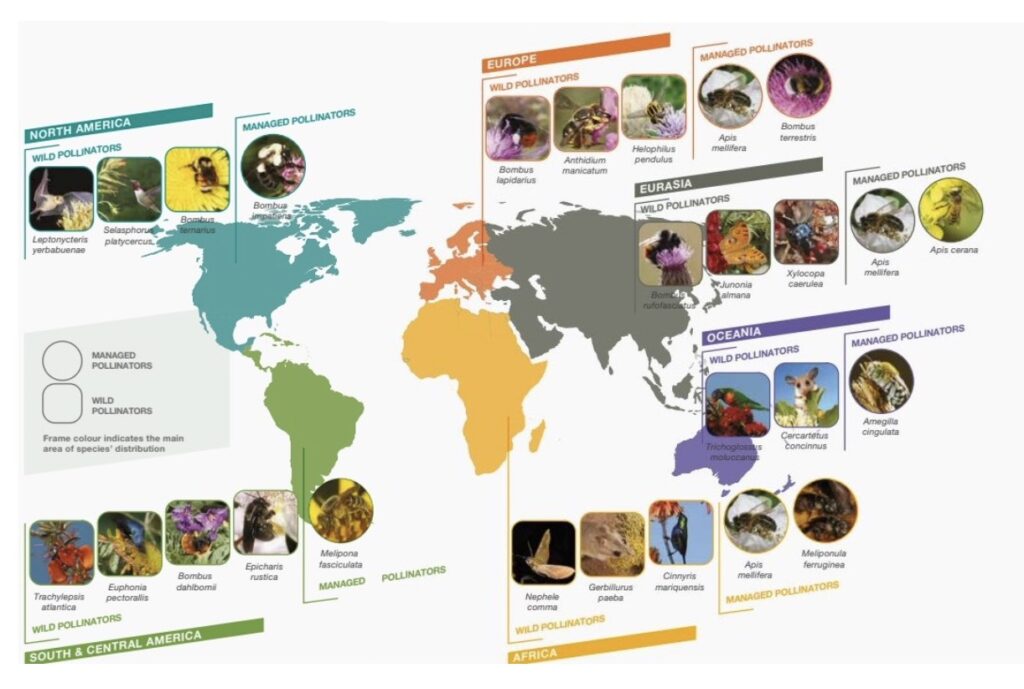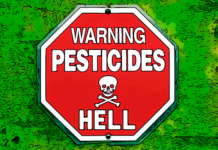May 20 is World Bee Day, and international organizations are at work but there is no suitable policy in the world to mitigate their decline.
The indispensable role of these pollinating insects in preserving life on the planet-and the threats they face from toxic anthropogenic activities-in a brief review.
1) World Bee Day.
World bee day (World Bee Day) was established on Dec. 20, 2017 at the initiative of Slovenia, which, after several years of attempts, managed to convince the United Nations to give an annual anniversary to these pollinator insects, key players in protecting the environment, biodiversity and agricultural production. (1)
FAO(Food and Agriculture Organization), in promoting the initiative, already stressed in 2019 that:
– declining bee populations pose a serious threat to food security and human nutrition,
– the increasing spread of high amounts of pesticides in the environment is the most serious threat to the survival of pollinating insects,
– climate change, in addition to unsustainable agricultural practices (e.g., intensive monocultures), exacerbates the loss of biodiversity and thus of pollinating insects. (2)
2) Pollination and food production, the IPBES report.
IPBES, Intergovernmental Science-Policy Platform on Biodiversity and Ecosystem Services, published a report back in 2016 where it highlighted the critical issues facing bees and pollinating insects-as well as humans. Ad memoriam, some passages from it are recalled:
– pollinating insects, which include more than 20,000 species of bees, are mostly wild species. Flies, butterflies, moths, wasps, beetles, thrips, as well as birds, bats, and other vertebrates. Some bee species-such as western honey bee(Apis mellifera), eastern honey bee(Apis cerana), some bumblebees, some stingless bees and some solitary bees-are widely managed,
– the contribution of pollinators is critical to the production of food, but also medicines, biofuels (e.g., canola), fibers (e.g., cotton, flax), building materials (e.g., lumber), and many other goods essential to human society,
– the survival and health of bees is threatened first and foremost by the use of pesticides and herbicides, which must therefore be drastically reduced, including through the use of non-toxic alternatives. Their massive use in conventional (i.e., non-organic) agriculture, exaggerated on herbicide-resistant GMO crops (almost all of them) drastically reduces food sources for pollinating insects, as well as causing the
Colony Collapse Disorder
,
– additional threats, in addition to climate change, come from pathogens (e.g., Varroa destructor, Paenibacillus larvae and Melissococcus plutonius for American and European plague, respectively). (3)

3) European Union, from ‘Save the Bees and the Farmers!‘ initiative to ‘Pact for Pollinators‘
‘Save the Bees and the Farmers! (‘Let’s save the bees and the farmers!‘) – European Citizens Initiative aimed at obtaining a ban on the use of the toxic pesticides and herbicides in EU agriculture (4)-gathered more than 1.2 million signatures in just a few months, more than 120 percent of those needed to force the European Commission to consider the appropriateness of a proposal for an EU regulation (and justify any refusal).
To the call for rules cogent, however, the European Commission responded-in violation of its duties-with a communication where it describes the framework for action that the EU and member states should take to limit the decline of pollinators by 2030, taking into account the Initiative ‘Save the Bees and the Farmers‘ and of the EU Biodiversity Strategy by 2030. (5) No duty, words to the wind. In fact, a real mockery.
4) EFSA, risk assessment for pollinators of agrochemicals.
Meanwhile, EFSA has published the 2023 revision of the guideline on how to assess the risk of agrochemicals on Apis mellifera and other species, in agricultural areas. (6) The now-defunct reg. EC 1107/09 in fact requires that ‘plant protection’ products can only be approved if it is demonstrated through appropriate risk assessment that they have no unacceptable effects on the environment, including non-target species such as bees. (7)
Nevertheless, 33 percent of the agrotoxics still authorized in the Old Continent lack updated risk assessments. On a par with the venomous glyphosate, as seen. Enforcement of the current rules remains wholly inadequate, which is why back in 2021 the European Ombudsman censured the Commission. And the proposedSustainable Use and Reduction of Pesticides (SUR) regulation has been boycotted by the big agricultural lobbies, serving and in conflict of interest with the pesticide and seed monopolists(Big Ag, Big 4).
5) IUCN Red List, the barometer of life.
The international organization IUCN(International Union for the Conservation of Nature) has offered a critical indicator of the health of biodiversity, a ‘barometer of life’ since 1964. Through participatory monitoring-to which its 1,400 governmental and nongovernmental members and more than 13,000 volunteer scientists and experts contribute-on 150,300 species, of which 42,100 are endangered.
IUCN Red List
provides-regionally and globally-information on the range, population size of individual species, habitat and ecology, use and/or trade, threats, and conservation actions. With the goal of informing policy-makers on actions needed to conserve nature. (8) In the European region:
– 1,965 bee species are identified as native, with a presence predating 1,500 B.C.
– the Mediterranean (Italic, Iberian and Balkan peninsulas) represents the richest belt of species, especially endemics,
– the South Central is the most threatened area, with 9% of the species at sure risk of extinction and 55-65% at possible risk of threat/extinction, which, however, cannot be estimated due to lack of scientific data, (9)
– in Italy, Apis mellifera and bumblebees(Bombus spp.) frequent more than 80 percent of the existing natural flora (herbaceous, shrub and tree, food and non-food). Out of a total of 151 species, nonetheless, 21 are endangered and 13 near threatened status. Frequent fires add to the risks already highlighted. (10)

6) FAO. Call for global protection of pollinating insects
A recent study by FAO and INRAE (France) highlights the need to protect not onlyApis mellifera (and A.m. ligustica, A.m. carnica, A.m. scutellata)-the honeybees-but also all other species of the Apis genus. Namely Apis cerana, florea, dorsata, laboriosa, nigrocincta, andreniformis, binghami, breviligula, koschevnikovi, nuluensis. Which are also threatened by pesticides and other factors but receive less attention due to the absence of economic returns (e.g., honey production). (11)
Honey bees have tended to be stable (in some cases even increasing), but other pollinators-which include species other than the genus Apis (e.g., Apis bumblebee, stingless bees, mason bees-are steadily declining. And their genetic diversity ( Apis genus included) is also generally at risk.

7) FAO, bee initiatives.
FAO, together with the United Nations, provides numerous services to monitor the health status of bees and promote their defense. Among them:
– Global Action on Pollination Services for Sustainable Agriculture, developed from the International Pollinator Initiative (IPI) where pollination is promoted as a fundamental process for natural ecosystems and human-managed agro-ecosystems. Thus, the Pollination Information Management System (PIMS) was developed for the purpose of better pollinator management, (12)
– Promotion of biodiversity conservation (including bees), by the Commission on Genetic Resources for Food and Agriculture (CGRFA), for more sustainable agriculture and food, (13)
– publications related to bees and pollinators, with regard to good beekeeping practices, responsible use of antibiotics (only where strictly necessary), pesticide control, disease control, and more. (14)
8) Italy. LIFE BEEadapt, ‘Generation Honey‘
BEEadapt
– an Italian project, funded by the European LIFE program – kicked off in September 2022, with a duration of 4 years. Aiming to establish effective pollinator adaptation measures to climate change, increase ecological connectivity and habitat heterogeneity through:
– The implementation of ‘pollinator-oriented‘ green infrastructure within urban, peri-urban and rural areas, and
– The establishment of multilevel governance systems for the better management of pollinator-friendly territories. (15)
‘Generation Honey’
is a two-year project sponsored by Agri Rete Service to improve knowledge of hive products andApis mellifera ligustica. Through the promotion of the national honey market and bee products, it aspires to promote beekeeping and thus also the protection of these insects. (16) The project was funded by MASAF, through CAP, with a total allocation of 17 million to support the sector. (17) Crumbs, compared to other livestock sectors, for a species without which there would be no agriculture, no food sovereignty and no forests (nor so the ministry itself).
9) Interim Conclusions
World days are not enough; bees are essential to the protection of environmental and food biodiversity but are still completely lacking in the policies and economic interventions needed to protect them.
#Savethebeesand the farmers!
Dario Dongo and Andrea Adelmo Della Penna
Notes
(1) Republic of Slovenia. World Bee Day. https://www.gov.si/en/registries/projects/world-bee-day/
(2) FAO. Declining bee populations pose threat to global food security and nutrition. https://www.fao.org/news/story/en/item/1194910/icode/
(3) IPBES. The assessment report on pollinators, pollination and food production – Summary for policymakers. https://www.ipbes.net/sites/default/files/spm_deliverable_3a_pollination_20170222.pdf
(4) Dario Dongo, Guido Cortese. Save The Bees! The reasons for the European citizens’ initiative. GIFT (Great Italian Food Trade). 15.06.19
(5) Communication from the Commission. Review of the EU pollinator initiative. A new pact for pollinators. COM(2023) 25 final. https://eur-lex.europa.eu/legal-content/IT/TXT/PDF/?uri=CELEX:52023DC0035
(6) EFSA (2023). Revised guidance on the risk assessment of plant protection products on bees (Apis mellifera, Bombus spp. and solitary bees). EFSA Journal 21(5):7989, https://doi.org/10.2903/j.efsa.2023.7989
(7) Regulation (EC) 1107/2009, Annex II, Section 3.8.3
(8) IUCN. 2022. The IUCN Red List of Threatened Species. Version 2022-2 https://www.iucnredlist.org/
(9) Nieto et al. (2014). European Red List of Bees. Publication Office of the European Union https://bit.ly/3MKt2lZ
(10) Quaranta et al. (2010) IUCN Red List of Threatened Italian Bees. IUCN Italian Committee and Ministry of the Environment and Protection of Land and Sea, Rome. http://www.iucn.it/pdf/Comitato_IUCN_Lista_Rossa_delle_Api_italiane_minacciate.pdf
(11) Halvorson et al. (2021). Protection of honeybees and other pollinators: one global study. Apidologie 52:535-547, https://doi.org/10.1007/s13592-021-00841-1
(12) FAO. FAO’s Global Action on Pollination Services for Sustainable AgriculturE https://www.fao.org/pollination/en/
(13) FAO. Biodiversity for food security and nutrition https://www.fao.org/cgrfa
(14) FAO. The importance of bee-ing pollinators. https://www.fao.org/publications/home/news-archive/detail/the-importance-of-bee-ing-pollinators/en
(15) Life BEEadapt https://www.lifebeeadapt.eu/
(16) Generation Honey. Italian honey from Italian bees https://generazionehoney.it/
(17) MASAF. Lollobrigida: increased from 9 to 17 mln resources for bee sector, signed decree. https://www.politicheagricole.it/decreto_api Press release. 5.12.22









